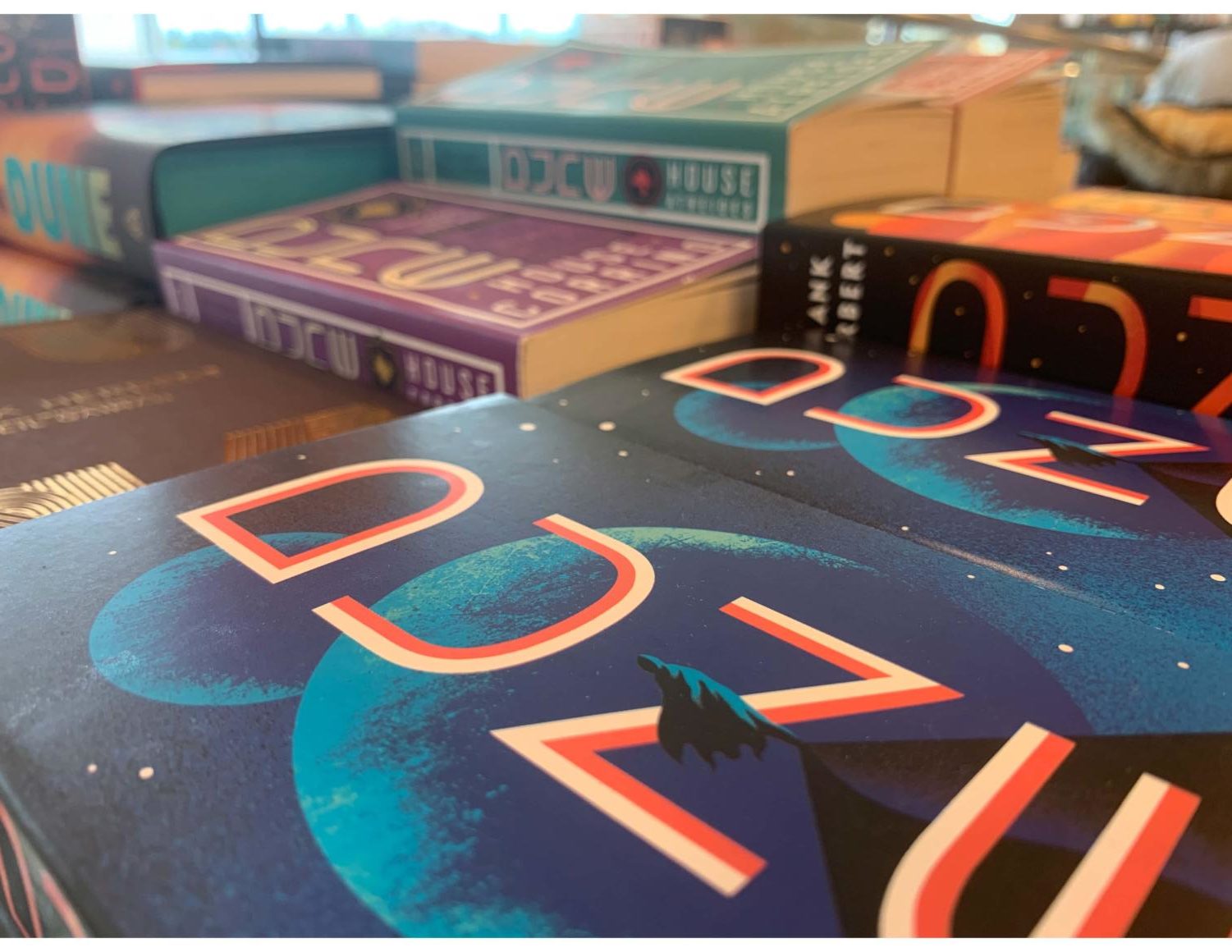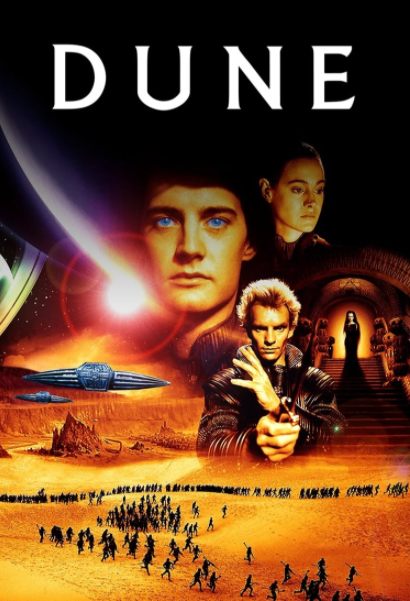Your donation will support the student journalists of West Linn High School. Your contribution will allow us to continue to produce quality content by purchasing equipment, software, and continuing to host our website on School Newspapers Online (SNO).
Dune: past and present
A comparison of the sci-fi epic's two film adaptations
November 9, 2021
Introduction
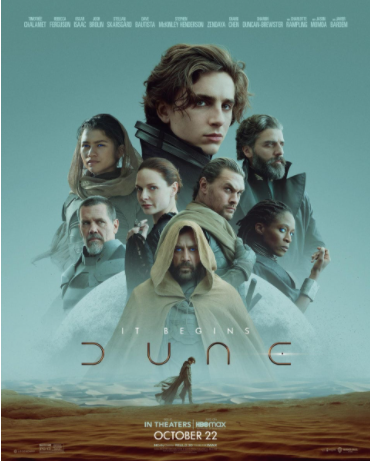
Courtesy of Warner Bros. Pictures
The “Dune” 2021 poster reflects the film’s focus on lighter, desert toned colors.
The sands of time may shift, but 56 years after its first printed edition was released, “Dune” is still one of the most critically acclaimed science fiction novels ever written. Inspired by the sand dunes of the Oregon Coast, a standard edition of “Dune” by Frank Herbert is a little over 800 pages of interstellar drama, with all of the trappings of an Ancient Greek epic, set roughly 20,000 years in the future. Its complex universe— defined by warring houses, enhanced human computers, mysterious pseudo-religious organizations, and other futuristic entities— is ruled by an emperor who is slowly losing control of his empire, as the houses around him gain political clout and influence.
As the inaugural winner of the Nebula Award for Best Novel, “Dune” has sold over 20 million copies and been translated into 14 of languages. It has had a clear influence on the original “Star Wars” trilogy, as well as the universe of “Game of Thrones”. Despite the success of these franchises, “Dune” itself was considered unfilmable for decades leading up to and following the first film adaptation in 1984.
After multiple attempts to adapt the novel failed, the 1984 movie, directed by David Lynch and starring Kyle MacLachlan, finally made it into theaters, only to be critically panned, failing to make back its $40 million budget. Later, a limited TV series on SyFy, released in 2000, would attempt to break the curse. However, unlike its predecessor, instead of becoming infamous, it faded into obscurity and was largely forgotten. Now in 2021 a second “Dune” film adaptation has premiered to critical acclaim and a box office total that would have paid the entire budget of the original in its opening weekend. The success of this new adaptation begs the question, why did the original fail when the remake has been so well received by both critics and the general public?
Synopsis
Courtesy of Universal Studios Pictures
Unlike the modern version the 1984 poster has darker elements, selling viewers more on the space aspect of the film than the desert.
“Dune” follows a fifteen-year-old boy named Paul Atredies on his journey to becoming the Emperor of the known universe. His story starts when he finds out his father, Duke Leto of House Atreides, has gotten a charter to mine spice, a powerful drug that enables space travel. This charter is on the planet Arrakis, better known as Dune. His mother Jessica, is part of the Bene Gesserit order, a mystical all female organization that manipulates the politics of the empire. This order believes in the coming of the Kwasitz Haderach, a boy foretold to be born with the ability to see into the past like the Bene Gesserit, and become the savior of the universe.
On the planet Arrakis, the Harkonnen house has gotten rich off mining the spice there at the expense of its native people, the Fremen. When the Harkonnens learn House Atreides is coming to rule Arrakis they successfully sabotage the Atreides family after they arrive, killing the duke and stranding Paul and his Bene Gesserit mother, Jessica, in the vast desert of Arrakis. The Fremen eventually take them in and Paul works his way through the ranks of the Fremen, learning more about the ways of the Bene Gesserit, and falls in love with a Fremen girl named Chani.
Two years pass, and Paul grows more powerful. Eventually, he decides to try to drink the water of life, which is fatal to males. He falls into a deep coma, survives, and becomes the Kawasitz Haderach. Later, the Emperor and House Harkonnen return to attempt to retake the planet from Paul and the Fremen. After a winning Fremen-style duel with Feyd-Rautha, the nephew of the leader of House Harkonnen, the Emperor allows Paul to marry his daughter, Princess Irulan, and take control of the empire.
1984
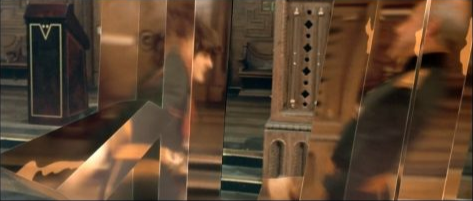
Courtesy of Universal Studios Pictures
Paul Atreides (Kyle MacLachlan) duels with his mentor Gurney Halleck (Patrick Stewart) using shields in the 1984 “Dune” adaptation.
The first “Dune” adaptation was riddled with problems, the largest being the year it was created in. The technology necessary to make a “Dune” movie simply did not exist in 1984.
In the book, the shields that the characters wear while fighting are invisible unless struck, however, in the 1984 film they are semi-translucent blocks that make it nearly impossible to discern where one character ends and the other begins. Computers and effects in the 1980’s were primitive by today’s standards, leading to an almost sloppy setting, throughout much of the movie.
Another glaring issue with the 1984 “Dune” is that it tried to squeeze an 800 page book into 2 hours and 17 minutes. It was simply not enough time to fully actuate Paul Atreides’ transition from the young, sheltered son of a duke and a Bene Gesserit, to the Kwisatz Haderach. The film cuts out the majority of his time with the Fremen making not only his character arc feel rushed, but his relationship with Chani feel strangely forced.
The book makes a point to mention the fact that Paul is 15 frequently, but in the 1984 movie he looks closer to 25 than to 15, and his age is not mentioned in the film. This changes the viewer’s perception of the character drastically, where in the book Paul seems young and vulnerable surrounded by adults whom he is reliant on, Paul in the movie is treated almost as an equal and seems self sufficient. Being older takes away a lot of the important character growth, both literally and emotionally that Paul receives during the book.
The 1984 “Dune” movie should not be judged harshly. It is a product of its time and, because of that, it is not done as well as the modern “Dune” movie, but for all of its limitations, lack of available technology, short run-time, and questionable plot choices, it was still a decent movie. Even if it’s entertainment value comes more from quips and Sting playing Feyd-Rautha rather than beautiful scenery or compelling dialogue, it still has become a cult-classic.
2021
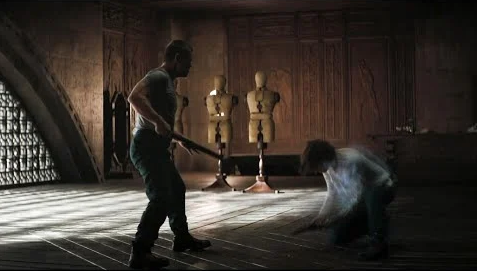
Courtesy of Warner Bros. Pictures
Paul Atreides (Timothee Chalamet) duels his mentor Gurney Halleck (Josh Brolin) using shields in the 2021 “Dune” film.
When a second full length film adaptation of Herbert’s novel came out nearly 40 years later, fan anticipation was high. Directed by Denis Villeneuve and starring Timothee Chalamet, the 2021 “Dune” movie does not suffer from any of the technical limitations of the original, and features sweeping desert visuals along with excellent CGI. This movie is one you almost have to see in a movie theater to get the full experience because of its scale. The dunes and sandworms are massive, and the size of the buildings, ships, and environment are constantly reminding you of how small and insignificant the characters are in comparison to the vastness of the desert.
The contrast in the sound design of “Dune” reels in its audience. Hans Zimmer’s score quietly lulls viewers into thinking everything is alright before blasting away their sense of security with a wall of sound. It is a massive improvement on the score of the 1984 version, which was done by Toto and felt a little bit out of place. The foreboding operatic vocals that accompany the Bene Gesserit are very different from the heroic theme that follows an appearance of Paul or Chani, with the stark difference between the two helping viewers understand how they are supposed to feel about the characters. Paul is supposed to feel young and naive, while the Bene Gesserit are intimidating and wise, and the score helps get those emotions across.
As the first part of either a two or possibly three movie project, Villenueve’s “Dune” movie has a lot more room to breathe. A three part movie series like “Lord of the Rings” is how “Dune” should have been done in the first place. The 1984 version, as a standalone film, did not have enough time to correctly develop the characters as they were developed in the book. By breaking up the films into a series, Villenueve has already fixed one of the 1984 films largest issues. The extra time the movie gets from being split into multiple parts shows in all of the extra visions Paul has and the time they get to spend on Caladan.
Both movies were relatively faithful to the book, but the 2021 “Dune” was able to include some less important scenes that 1984 had to cut because of its extra time. It also spends more time on landscape shots than the original does, because of its updated technology and CGI composed by the VFX studio DNEG. Where the 1984 version avoided showing long shots of the desert on Arrakis, the 2021 reboot spends a large portion of its run time there.
Despite all of this, 2021 “Dune” is not without its faults. It gives very little screen time to the Harkonnens, opting to instead try to emphasize their brutality with a few cut away shots of them slicing off the heads of Atreides guards. The lack of focus on the villains of the movie doesn’t allow characters like Rabban, played by Dave Batuista, to become intimidating to the audience. In fact the Bene Gesserit, who are neither good nor evil, are treated as a more dangerous subject than the actual villains of the movie.
There is also the subject of the Mentats, human supercomputers that aid in military strategy and do calculations for the characters throughout the book. They exist and are semi-important characters in the movie, but their abilities are never explained. Mentat characters like Thufir Hawat, played by Stephen McKinley, have their eyes turn white from time to time, and then spit out information. The lack of explanation for this is a huge break from the book. In the book Paul is in training to become a Mentat, but in the movie, because it is never mentioned it appears he is not. Being a Mentat is not a crucial part of Paul’s character, but it is important and does allow Paul to do things a normal person would not be able to later in the book.
As a whole, the 2021 remake of “Dune” is a massive improvement on the original, both for reasons it can and cannot control. The scenery, dialogue, and score of the new version all contribute to making “Dune” feel like a complete and full movie even if it is only the first part of a larger story. Updated technology is in large part to thank for these improvements, but some of it is the intangible way that this movie seemed to capture the spirit of the book in a way that past adaptations couldn’t. “Dune” is a book deserving of a good movie, and now in 2021 it finally has one, but whether the trend continues and its sequels can live up to the new original is still to be seen.
